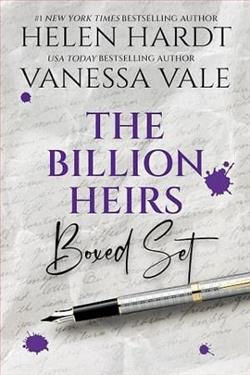Page 28 of Writing Mr. Right
“We’re going to start spinning now,” Penelope declares. “But before we start, make sure your elbows are locked to your legs.” She wets her hands again and turns on the wheel. As the clay spins, she cups her hands around it. “Use your left hand to push the clay up while using your right hand to support it. Then, use the palms of your hands to squeeze the clay inward—that allows the clay to pop up between your hands.” She demonstrates, and the wet clay pushes upward into a cone shape. “While the clay gets taller, keep an A-shape with your thumbs.”
As expected, Aashiq picks up the instructions with little difficulty, and his grin grows as his clay does. His fingers delicatelypinch and press and form the lip of the bowl. It’s beautiful and effortless work.
And, as expected when I try, the clay teeters to the side. The curve in the shape morphs it into something like an elephant trunk, and as my wheel spins, tiny bits of water and clay flick outward. “Damn it!” I hiss as I grab the clay and try to force it back into a straight position.
Aashiq leans over again, and he doesn’t even pause in his clay-making as he says, “I think your wheel is spinning too fast.”
“Thanks, Igotit,” I snipe.
Aashiq flinches at my tone. He drops his gaze to focus on the clay in his hands.
A sigh rumbles the back of my throat. I know my anger isn’t about him, but it’s hard seeing him be so…perfect all the time. He’s never in a bad mood, he charms the pants off my coworkers,andhe’s a master at making pottery right out of the gate? It’s annoying that he’s so good at the things he wantsmeto improve on. It’s like somehow, he’s a better version of me, even though he’s technicallypartof me.
Sometimes he seems less like my writing muse and more like my mirror reflection, except instead of showing me who I really am, he shows me who I could be—and that hurts way more.
13
Aashiq doesn’t speak to me for the rest of the class, and it somehow feels worse than the fact that I’ve absolutely butchered clay-making. I thought his comments were annoying, and the way that he was leaning into my personal space was bothersome, but now that he’s not doing it anymore, I miss it.
To distract myself, I throw myself into the clay-making. I tried to follow Penelope’s example, but my clay morphed into something completely unrecognizable. And we were only supposed to be making bowls, which, by all measures of clay-making, should have been simple. Mine is like a half-smashed flowerpot someone squished with their heel. Seriously, I don’t know what I was thinking when I agreed to this. I should have left when I saw the store name.
Great. Just great. Not only am I a failure as a writer, but I’m a failure at art in general. Am I wasting my time on something I’ll never succeed at?
By the time the class is over and Penelope wanders over to give compliments and tips for next time, I’m tempted to hide my monstrosity under the table, especially when she stops nextto Aashiq and showers him with praise. I’m going to be the last person she talks to, and half the room is already empty.
I debate it back and forth in my head, and just as I decide to toss my pottery to the floor and act like I accidentally knocked it over, Penelope reaches my table. “Well, Ziya, let’s see what you—” She cuts herself off midsentence as her eyes take in my mutant pot. “O-oh,” she says, and the hesitation in her eyes clearly suggests she’s desperately racking her brain to figure out a compliment she can pay my work before she tears it to shreds.
This isn’t my first time getting soul-destroying feedback, though, so I just toss my hands in the air. “It’s okay, you can say it,” I assure her. I rub my clay-crusted hands together. “It’s awful.”
“No, notawful,” Penelope instantly says—I’m sure as a teacher it’s her instinct to cheer students up when they’re discouraged. “It’s just…what was your focus on?”
I furrow my brows. “What do you mean? I was trying to make the stupid pot, but every time I thought I hadfinallyperfected something, I made a move that derailed everything.”
“Ahh, nowthere’syour problem,” Penelope says, though not unkindly. “You were so focused on making things perfect that you forgot the fun.”
“But…the purpose of art is to make something worth showing,” I argue. “If the end product isn’t something that’s without imperfections, then what’s the point?”
Penelope regards me for a long moment, then says, “Wait here,” before wandering off to a room in the back. Aashiq and I don’t speak the whole time she’s gone, and even though it’s only a few minutes, it feels like a stretched eternity. Finally, Penelope comes back, and when she circles around me, she holds out a ceramic dark blue bowl. “Here.”
I take it from her. At first glance, it’s like a regular bowl. But then I spot the cracked golden lines painted on the outside and inside. The off-kilter design mars the otherwise perfectlycrafted bowl. I glance back up at Penelope. “What is it? Why does it look ruined?”
“This is a bowl I made using kintsugi,” Penelope begins. “It’s a Japanese art form. You take broken pottery and mend the areas of breakage with urushi lacquer mixed with powdered gold.” Her fingertip traces one of the golden lines along the edge of the bowl. “And the part you callruinedis exactly what the kintsugi highlights. It brings attention to the imperfections of the art. It makes them a part of the bowl’s history, rather than something that needs to be hidden. It can’t change what’s already happened; nothing’s going to unbreak the bowl. But it shows we can recognize what the bowl has been through, and instead of trying to cover it up and act like the cracks were never there, we can embrace them and let the bowl become something beautiful again.” She splays her hand out. “Itsowndefinition of beautiful. Not anyone else’s.”
I tilt my head to the side and glance back down at the bowl. With Penelope’s words as a new lens, my perception of the pottery changes. She’s right; it’s not ruined. The warped lines give the bowl an intriguing image. It catches the viewer’s attention and gives the bowl personality. I can’t help personifying it—instead of giving up, instead of accepting defeat, this bowl proved it had the strength to try again. It proved that trying again isn’t something to be ashamed of. There’s beauty in a new beginning even while remembering what it took to get there. “I guess I’ve…never thought of art like that before,” I confess.
“Not many people do,” Penelope replies. She crosses her arms behind her back. “We’re more concerned with wanting everything to be perfect right from the get-go. Especially when old projects don’t work out the way we want them to. It’s like we need the new ones to do the work those old ones couldn’t. We want to prove to ourselves thatwearen’t failures.”
Wow. Is this lady the physical manifestation of all my fears when it comes to writing? I’ve been too afraid to start a newproject because the pain of the last one still scars me. I guess Rachel’s rejection cut deeper than I thought, but I’ve been doing all I can to cover those scars up. Still, every time I try to think of a new project, her harsh words echo in my ears and make me run in the opposite direction, because I don’t want to get hurt like that again. I never thought to embrace rejection as part of moving forward. To recognize my failures but not condemn myself for them, or think that just because I failed, I can’t try again.
She picks up my distorted clay creation and holds it up. “We’re never going to get things right from the beginning. Any art takes time, patience, and devotion. And most importantly, a desire not to give up. But not to prove to others that we’re capable, and not even to prove toourselvesthat we’re capable. It’s because as artists, we have to feed the part of our soul that craves creation.” Her eyes brighten. “Listen, I have to keep your pottery to glaze it. But next week, when you come to pick it up, stay for a while and paint it. Sometimes all something needs is a splash of color to make it shine.”
“Okay,” I agree. “And thanks for what you said. It really resonated.”
I hold the bowl out to her, but Penelope pushes my hand back. “Keep it,” she insists. “To remind you of the importance of imperfections.”
I give her a grateful smile. “I’ll remember.”
“See you next week,” she says, bidding me goodbye as she picks up my supplies and carries them to the back of the room.















